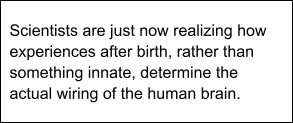Welcome back to another round of Tricks of the Trade, where you’ll learn insider secrets to elevate your SAT and/or ACT prep to the next level! Last time you learned when and how to guess strategically, and this week we’ll be diving into the “meat and potatoes” of test prep: the process of elimination (POE). POE is the #1 strategy for efficiently maneuvering past all those sneaky trap answers that are so common on standardized tests like the ACT and SAT.
How to Use POE
Here’s one of ACT’s official Reading sample test questions (which could just as easily appear on SAT Reading):

As it is used in the passage, the phrase something innate most nearly means:
A. a memory
B. learned behavior
C. physical immaturity
D. an inherited trait
At first glance, it may not be obvious which answer is best. Maybe you’re not completely sure what “innate” means. Maybe one choice sticks out to you right off the bat. No matter which boat you’re in, methodically applying POE to the answer choices of every single question is a simple yet effective strategy to ensure accuracy by avoiding traps!
Step 1: Make Your Own Prediction
To make a prediction, we look for clues in the passage. Within this sentence, we see that “something innate” is contrasted with “experiences after birth”. We can rephrase in our own words: “experiences after birth, rather than something you’re born with.”
Step 2: Weed Out Answers That Don’t Match Your Prediction
Let’s start with A. Is a memory something you’re born with? Nope. Cross it off.
Now B. Is a learned behavior something you’re born with? Definitely not. Next!
We’ve made it to C. Is physical immaturity something you’re born with? Well, technically, yes. We don’t cross it off like the others, but we can’t move on without looking at D.
D, “an inherited trait”, is also something that you’re born with. Hmm.
Let’s see what our question looks like now that we’ve eliminated multiple wrong answers:

As it is used in the passage, the phrase something innate most nearly means:
A. a memory
B. learned behavior
C. physical immaturity
D. an inherited trait
Step 3: Carefully Examine Any Remaining Answers
Now we’ll dig a little deeper into choice C. This sentence is talking about what determines the wiring of the human brain, and “physical immaturity” doesn’t really make sense in this context. Even though you’re technically born with it, physical immaturity is not something that clearly contrasts with “experiences after birth”.
After eliminating C, we know that D is our final answer. “An inherited trait” is something that could directly contrast with “experiences after birth” and determine brain wiring.
Another Example
Let’s take a look at a different type of question, one that could appear on either SAT Math or ACT Science.

At its current rate, which is the most reasonable estimate of the distance a sloth would cover in 2 minutes?
A. 6 feet
B. 9 feet
C. 12 feet
D. 15 feet
For this question, a quick look at the graph allows us to predict that the correct answer will be a number larger than 10 (Step 1). We can therefore eliminate A and B, which are clearly too small (Step 2).

At its current rate, which is the most reasonable estimate of the distance a sloth would cover in 2 minutes?
A. 6 feet
B. 9 feet
C. 12 feet
D. 15 feet
For Step 3, we have a few different options. We can use a pencil to continue the red line and then make a visual assessment (e.g. that the distance should be a little bigger than 10). To be more exact, we may also calculate that this line has a slope of 6: the sloth has moved 6 feet in 1 minute, and in 2 minutes it will have moved 12.
This wasn’t a particularly difficult question, but notice how POE helped us to eliminate half of our possible answer choices. On more challenging problems, any wrong answer you’re able to cross off significantly increases your odds of guessing correctly!
In the coming weeks, we’ll talk more about applying POE to the various sections of both the SAT and ACT as I introduce you to more Tricks of the Trade, including trap answers, math shortcuts, and many others! If you just can’t wait that long and would like to get a jumpstart on your personalized path to standardized test success, schedule your free consultation with one of our Student Success Advisors today!

